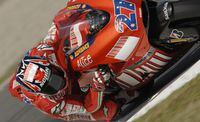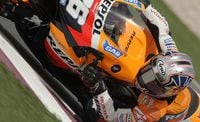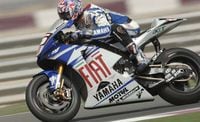Bridgestone won and Michelin lost; that’s the blunt outcome of the 2007 USGP. Less than a year ago, Bridgestone personnel were bemoaning their inability to build a rubber compound that could work well on newly laid tarmac. Now, they can annihilate their main opposition on exactly that sort of surface. But is that because Bridgestone has gotten better? Or is it because their opposition has dropped the ball?Bridgestone’s success this year is the culmination of seven years’ work; not too many companies would be that patient. Back in 2001, the first steps involved a Honda NSR500, crew chief Erv Kanemoto, a whole bunch of tires and a year-long test program.
Getting the Japanese rubber onto top bikes took time, but the pivotal decision came when Ducati opted to follow a strategy of differentiation. The Italian bike-maker wanted a tire that would give it the opportunity to win whenever Michelin had a “bad day.” With both Honda and Yamaha sticking to Michelins, and with Ducati determined to build a bike that performed at least as well as those produced by the Japanese, all Bridgestone had to do was deliver whenever Michelin was likely to be in trouble.
In recent years, Michelin’s competitive advantage has been its ability to deliver finely tuned track- and condition-specific tires to any European circuit overnight. Bridgestone’s tactic to counter Michelin’s late-delivery strategy was to use dedicated test teams that visited the tracks before the GPs, researching grip levels and finding suitable compounds. It was the prospect of matching these teams that led Michelin to sacrifice its Saturday-night delivery and support the new “choose-all-your-tires-on-Thursday” rule.
Then for 2007 Ducati signed a youngster named Casey Stoner—its third choice, actually—and proceeded to build a bike that is the peach of the new 800s. Critically, Michelin underestimated the strength of the carcass that would be required to support the high cornering loads dished out by the new class. By Mugello, things were improving; Assen saw further improvement. Now, however, Michelin has to change its compounds. Opting for rubber that is less temperature-critical will allow its teams an easier task of finding something that works within their 31-tire allocation. They don’t have long; 2008 contracts are now being negotiated, and there is already suspicion that the Honda and Yamaha works squads are queuing up for Bridgestones.
Sound Off! How important is the rider in MotoGP?








/cloudfront-us-east-1.images.arcpublishing.com/octane/EFFSPCZVBBCMTNGVEQMB7NNKIU.jpg)
/cloudfront-us-east-1.images.arcpublishing.com/octane/5GP3PUGFKVGUVCEYG4ZBDYLNBE.jpg)
/cloudfront-us-east-1.images.arcpublishing.com/octane/USTSFGXT3ZGL7BT7B66WMSSKTI.jpg)
/cloudfront-us-east-1.images.arcpublishing.com/octane/Z7YU6FSR6NEKVMKT5CZPMKIVLE.jpg)
/cloudfront-us-east-1.images.arcpublishing.com/octane/MOP35BTV3FFANFBUJKU2RJRTZ4.jpg)
/cloudfront-us-east-1.images.arcpublishing.com/octane/UWTN4NTIJFD25MPXBOVS4DFOXE.jpg)
/cloudfront-us-east-1.images.arcpublishing.com/octane/SIFOY54XMFGEHAUYNFUYVW7IZ4.jpg)
/cloudfront-us-east-1.images.arcpublishing.com/octane/HMC5X3JZHRASXGVCVNBJBWWGSI.jpg)
/cloudfront-us-east-1.images.arcpublishing.com/octane/UIWGXRZDM5HZXJOWXET2DZIWJE.jpg)
/cloudfront-us-east-1.images.arcpublishing.com/octane/QSS5DZ6SKJEU3AKE4KDAWYBEFY.jpg)
/cloudfront-us-east-1.images.arcpublishing.com/octane/SMCEQCLWRVEFTJJES6TAHB3OOQ.jpg)
/cloudfront-us-east-1.images.arcpublishing.com/octane/JCACIDCAC5FUNPTXO2BOUHGGII.jpg)
/cloudfront-us-east-1.images.arcpublishing.com/octane/DC7ZGILA2BCJXHZIUNYGV7JSEA.jpg)
/cloudfront-us-east-1.images.arcpublishing.com/octane/EWJEZUGWEZGABDEQWB64WL46GQ.jpg)
/cloudfront-us-east-1.images.arcpublishing.com/octane/5NHBMRMSFVD5JAPFNMBMNPGXQE.jpg)
/cloudfront-us-east-1.images.arcpublishing.com/octane/WHE43SCPLJBRNANAJAGXHOAIEU.jpg)
/cloudfront-us-east-1.images.arcpublishing.com/octane/6R56AQAW6NDE7BBIJ3SMCOOY5A.jpg)
/cloudfront-us-east-1.images.arcpublishing.com/octane/JMQTUE2FKZFURJTJXDMM4V47AQ.jpg)
/cloudfront-us-east-1.images.arcpublishing.com/octane/P2QYJDMQNVEANMQFXHNB3OVFKQ.jpg)
/cloudfront-us-east-1.images.arcpublishing.com/octane/VNKGXM4AA5BPRGERJOPV6GADAQ.jpg)
/cloudfront-us-east-1.images.arcpublishing.com/octane/2WS4YIFLTNG25L25WP7ZFLSWJM.jpg)
/cloudfront-us-east-1.images.arcpublishing.com/octane/UXRS6ZVQZFC23FY2EDYNT5WMVA.jpg)
/cloudfront-us-east-1.images.arcpublishing.com/octane/7JETMCKNVRGDZIGB3JCITGLPUU.jpg)
/cloudfront-us-east-1.images.arcpublishing.com/octane/OZV6E2KNIJDVHGOKXQQ2AHKLHQ.jpg)